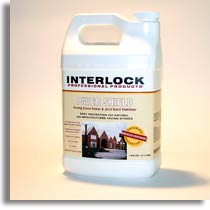Anything I can dream... my Honeyman can build.
And this is what he built for me... (and he let me help.)
We have a beautiful Patio (read our story here) built in 2009,
that we especially enjoy on warm Summer nights.

We packed our clay soil firmly in and around the blocks
to provide a solid base for the waterfall.
We'll further build this up with large river rock...
but wait, I'm getting ahead of myself,
that will be another day's post.
The answers to these questions will be discussed in our next post.
Stay tuned!
The adjacent landscape is striking...
but something was missing.
My heart yearned to hear the refreshing sound of water splashing
but something was missing.
My heart yearned to hear the refreshing sound of water splashing
in my gardens
at the end of a Summer's day.
(Anything I can dream?)
And so we began...
It was April of 2011
and our sleepy gardens were just beginning to awake.
Remember this is Utah
where all but the bones of the gardens
die back and all but disappear from the cold Winter months.
(One of the reasons I love the month of April ... watching as the barren landscape SPRINGS to life.)
We had dug out the bushes from the existing landscape in the Fall,
so we began by transplanting the emerging plants,
rerouting the sprinkler pipes
and scraping the garden soil down to the clay base...
but only where the waterfall and stream would be.
After all... this was my perennial garden and I didn't
want to disturb the emerging plants and slumbering seeds.
We stock-piled the scraped off garden soil
to later place around the waterfall and stream at project's end.
The head of the waterfall would be up near the house,
so we prepared a gentle slope down to the rocks already in place
that lined the perennial bed.
These were the river rocks that were gathered from our soil
when we first landscaped our property,
and we planned to incorporate them into the design of our stream.
at the end of a Summer's day.
(Anything I can dream?)
And so we began...
It was April of 2011
and our sleepy gardens were just beginning to awake.
where all but the bones of the gardens
die back and all but disappear from the cold Winter months.
(One of the reasons I love the month of April ... watching as the barren landscape SPRINGS to life.)
We had dug out the bushes from the existing landscape in the Fall,
so we began by transplanting the emerging plants,
rerouting the sprinkler pipes
and scraping the garden soil down to the clay base...
but only where the waterfall and stream would be.
After all... this was my perennial garden and I didn't
want to disturb the emerging plants and slumbering seeds.
We stock-piled the scraped off garden soil
to later place around the waterfall and stream at project's end.
The head of the waterfall would be up near the house,
so we prepared a gentle slope down to the rocks already in place
that lined the perennial bed.
These were the river rocks that were gathered from our soil
when we first landscaped our property,
and we planned to incorporate them into the design of our stream.
The foundation of the waterfall head
was laid in place with cinder blocks.

We packed our clay soil firmly in and around the blocks
to provide a solid base for the waterfall.
We'll further build this up with large river rock...
but wait, I'm getting ahead of myself,
that will be another day's post.
Surely growing weary of hearing my repeated cautions
to not step on my precious emerging peonies,
my Honeyman covered several of them with pots
to assure their safety in the construction zone.
What a guy.
Would contractors ever step so lightly?
to not step on my precious emerging peonies,
my Honeyman covered several of them with pots
to assure their safety in the construction zone.
What a guy.
Would contractors ever step so lightly?
♦ ♦ ♦
Our next post will include the engineering side of our project.
Did you know that the height of the waterfall
and the length and width of the stream are all determining factors
of how large the holding basin must be at the base of the stream?
Then there is the issue of the pump...
what size is right for your project?
The answers to these questions will be discussed in our next post.
Stay tuned!





















































